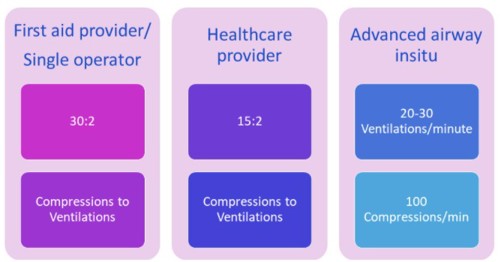Ventilation and Compressions Ratios in Paediatric Resuscitation
One of the differences between adult and paediatric resuscitation is the difference in ventilation to compression ratio recommendations. First aid responders utilise the same ratios regardless of age, which can create confusion between initial responders and healthcare professionals.
Adult resuscitation has a standard ratio of 30:2 compressions to ventilations. This remains the same regardless of a community or clinical setting, and does not change as the arrest moves into an advanced life support algorithm. Paediatric resuscitation has a slightly different approach, which reflects the fact that healthcare professionals have access to more equipment and understand physiological differences across age groups. 2020 ILCOR guidelines emphasise the importance of higher ventilations in paediatric resuscitation. This reflects the higher oxygen requirements of children which is evident in their higher baseline respiratory rate. It also acknowledges that paediatric arrests are more likely to be from respiratory aetiology, making ventilation with high flow oxygen a high priority in the management of these arrests. In a clinical setting CPR should be performed utilising 15:2 ratio compressions to ventilations, and where an advanced airway has been secured, continuous compressions with ventilations up to 20/minute. Updated ANZCOR guidelines should be released in 2021, so watch this space.
Suggested ratios for compressions and ventilations in paediatric resuscitation in accordance to 2020 ILCOR recommendations

If you would like to improve your knowledge and skills in responding to clinical emergencies you may be interested in attending our adult and/or paediatric advanced life support workshops. We have public events in Melbourne, Sydney and Brisbane in 2021. These workshops utilise a problem-solving approach and are based upon the current Australian Resuscitation Council guidelines.
For a full list of events and courses please visit https://medcast.com.au/critical-care.
References:
ANZCOR (2016). ANZCOR Guideline 12.2 – Advanced Life Support for Infants and Children: Diagnosis and Management.
Maconochie, I.K, Aichkin, R., Hazinski, M.F., etc (2020). Pediatric Life Support: 2020 International Consensus on Cardiopulmonary Resuscitation and Emergency Cardiovascular Care Science With Treatment Recommendations | Circulation (ahajournals.org), October; 142: S140-S184.
Royal Children’s Hospital Melbourne (2020). Resuscitation: Hospital Management of Cardiopulmonary Arrest. Clinical Practice Guidelines, Royal Children’s Hospital Melbourne.
Vega RM, Kaur H, Edemekong PF. (2020). Cardiopulmonary Arrest In Children. In: StatPearls [Internet]. Treasure Island (FL): StatPearls Publishing; 2020 Jan-.

Crystal Smith is a Senior Education Consultant for Critical Care Education Services (part of the Medcast Group). She has a clinical background in critical care, paediatrics and education.
Become a member and get unlimited access to 100s of hours of premium education.
Learn moreSuccessful resuscitation attempts rely on the optimisation of cerebral and coronary perfusion. For this to occur it is important to work like a NASCAR pit crew and deliver high performance CPR.
Laser safety in operating theatres is crucial for staff and patient protection. Implementing training, protective eyewear, safety protocols, and controlled access ensures effective surgical procedures and minimises risks like tissue damage. Prioritising these measures enhances overall procedural safety and effectiveness.
Recognising and responding appropriately to student disclosure of sexual violence at educational institutes is urgently needed to mitigate the significant adverse mental and behavioural outcomes of such conduct.
